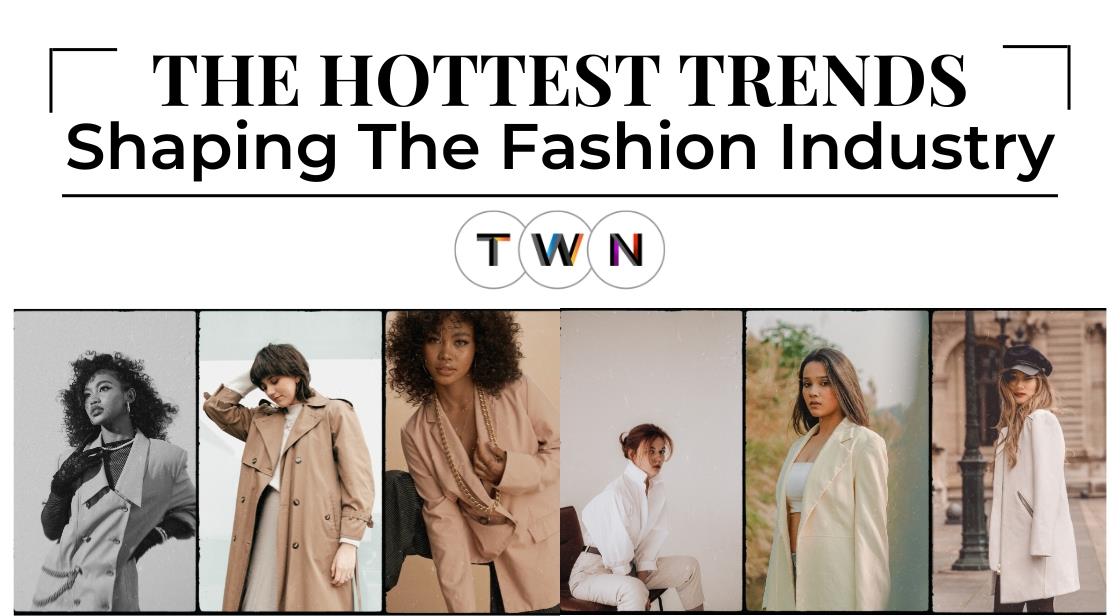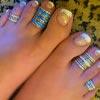The Hottest Trends Shaping the Fashion Industry Today

Blog Post
To begin exploring the hottest trends shaping the fashion industry today, It's critical to recognize how dynamic the fashion industry is. A wide range of elements, such as culture, technology, sustainability, and societal changes, continually impact fashion trends.
As a result, studying this subject demands a sharp observational eye as well as a thorough comprehension of the connections between fashion and other sociological components.
Examining current advancements and changes in customer preferences is one approach to begin learning more about this subject. This involves examining how growing awareness of social and environmental concerns has led to the emergence of sustainable fashion methods.
Additionally, examining the rise of gender-fluid apparel and the fuzziness of traditional fashion lines offers insight into shifting social mores and perspectives.
The effect of technology on the fashion business should also be taken into account. In particular, the introduction of wearable technology and the emergence of virtual fashion shows as a reaction to the digital era are noteworthy developments.
Furthermore, the rising appeal of DIY modification and the resurgence of vintage fashion are reflections of customers' need for uniqueness and self-expression.
Starting with these fundamental ideas and styles, we may develop a thorough grasp of the state of fashion today and the factors influencing its development. We may then go more deeply into particular trends and how they may affect fashion going forward.
Exploring the Latest in Fashion Industry Innovations
1. Sustainable Fashion: Eco-Friendly Materials and Practices
What is Sustainable Fashion?
Introduction to Sustainable Fashion:
Sustainable fashion focuses on reducing the environmental impact of clothing production and consumption while promoting ethical practices throughout the supply chain.
Use of Eco-Friendly Materials: Sustainable fashion utilizes environmentally friendly materials, such as organic cotton, hemp, bamboo, and recycled fabrics. These materials minimize the use of pesticides, chemicals, and water in production.
Ethical Production Practices: Sustainable fashion brands prioritize fair labor practices, ensuring workers receive fair wages and work in safe conditions. They often adhere to certifications like Fair Trade and promote transparency in their supply chain.
Reducing Waste: Sustainable fashion aims to minimize waste by embracing circular economy principles. This includes designing durable, timeless pieces, offering repair services, and implementing take-back programs for recycling and upcycling.
Innovative Technologies: Advancements in technology enable sustainable fashion, such as 3D printing, which reduces material waste, and waterless dyeing processes, which minimize water usage and pollution.
Consumer Education and Awareness: Sustainable fashion advocates for consumer education to raise awareness about the environmental and social impacts of Sustainable clothing production. This empowers consumers to make informed purchasing decisions and support ethical brands.
Collaborations and Partnerships: Collaboration between top fashion brands, NGOs, and government entities plays a crucial role in advancing sustainable practices. Joint initiatives help drive innovation and promote sustainability across the industry.
Regenerative Agriculture: Some sustainable fashion brands prioritize regenerative agriculture practices, which focus on restoring ecosystems and soil health, further reducing environmental impact.
2. Gender-Fluid Clothing: Breaking Traditional Norms
What is Gender-Fluid Clothing?
Introduction to Gender-Fluid Clothing:
Gender-fluid clothing challenges traditional gender norms by offering styles and designs that are not limited by binary gender categories.
Non-Conformity: Gender-fluid clothing embraces non-conformity and encourages individuals to express themselves authentically, regardless of societal expectations or stereotypes.
Diverse Styles: Gender-fluid clothing encompasses a wide range of styles, including androgynous, unisex, and gender-neutral designs. These styles blur the lines between traditionally masculine and feminine aesthetics.
Inclusive Sizing: Gender-fluid clothing often offers inclusive sizing options, accommodating a diverse range of body types and shapes without adhering to traditional gender-specific sizing charts.
Fluidity in Fashion: Gender-fluid fashion celebrates fluidity and flexibility, allowing individuals to experiment with different styles and expressions without limitations based on gender norms.
Fashion Icons: Influential figures in the fashion industry and popular culture have embraced gender-fluid clothing, challenging perceptions and inspiring others to explore their own identities through fashion.
Cultural Impact: Gender-fluid clothing has sparked important conversations about gender identity, representation, and inclusivity in the fashion industry and beyond.
Social Acceptance: While still evolving, gender-fluid clothing has contributed to greater acceptance and visibility of diverse gender identities, promoting a more inclusive and progressive society.
3. Athleisure Wear: Fashion Meets Functionality
What is Athleisure Wear?
Definition of Athleisure Wear:
Athleisure wear refers to clothing that combines elements of athletic wear with casual or everyday fashion, blurring the line between workout attire and streetwear.
Comfort and Versatility: Athleisure wear prioritizes comfort and functionality, allowing individuals to seamlessly transition from the gym to daily activities without compromising style.
Performance Fabrics: Athleisure garments often utilize performance fabrics such as moisture-wicking materials, stretchy fabrics, and breathable textiles, providing optimal comfort and mobility.
Stylish Designs: Athleisure wear incorporates stylish designs, trendy patterns, and fashionable cuts, making it suitable for both athletic activities and casual outings.
Layering: Athleisure wear encourages layering, allowing individuals to mix and match different pieces to create versatile and stylish outfits suitable for various occasions.
Accessories Integration: Athleisure outfits often incorporate accessories such as sneakers, baseball caps, backpacks, and sunglasses, enhancing the overall athletic-inspired aesthetic.
Rise in Popularity: Athleisure wear has surged in popularity in recent years due to the growing emphasis on health and wellness, as well as the increasing demand for comfortable yet stylish clothing options for everyday wear.
4. Statement Sleeves: Bold and Dramatic Silhouettes
What are Statement Sleeves?
Definition of Statement Sleeves:
Statement sleeves refer to sleeves on clothing items, such as blouses, dresses, and tops, that are designed to be bold and attention-grabbing, often featuring exaggerated or dramatic silhouettes.
Variety of Styles: Statement sleeves come in various styles, including puff sleeves, bishop sleeves, bell sleeves, lantern sleeves, and leg-of-mutton sleeves, each offering its own unique silhouette and aesthetic.
Exaggerated Proportions: These sleeves typically feature exaggerated proportions, with volume and drama added through gathering, pleating, ruffles, or layers of fabric, creating a striking and eye-catching look.
Fashion Statement: Statement sleeves serve as a fashion statement, allowing individuals to express their personal style and creativity through bold and dramatic silhouettes, adding visual interest and personality to an outfit.
Versatile Styling: Despite their boldness, statement sleeves can be styled in various ways to suit different occasions, from casual outings to formal events, making them a versatile and trendy choice in contemporary fashion.
Also Read: Top Fashion Brands: The Best Clothing Brands in the World
5. Vintage Revival: Nostalgic Fashion Resurgence
What is Vintage Revival?
Introduction to Vintage Revival:
Vintage revival refers to the resurgence of fashion trends and styles from previous decades, often characterized by nostalgia and a desire to revisit iconic fashion moments.
Reinterpretation of Classic Styles: Top Fashion designers and brands reinterpret classic styles from past eras, bringing them into contemporary fashion through modern silhouettes, fabrics, and styling.
Thrift Shopping and Second-Hand Fashion: The popularity of thrift shopping and second-hand fashion has contributed to the vintage revival trend, as consumers seek unique, one-of-a-kind pieces with a history.
Iconic Fashion Decades: Different decades see revival in fashion trends, such as the 1960s with mod-inspired looks, the 1970s with bohemian and disco styles, and the 1990s with grunge and minimalism.
Celebrity Influence: Celebrities and influencers often embrace vintage fashion, inspiring their followers to incorporate retro elements into their wardrobe and driving the resurgence of specific vintage trends.
Sustainable Fashion Choice: Embracing vintage fashion is often seen as a sustainable choice, as it promotes reuse and reduces the demand for new clothing production, thus minimizing environmental impact.
Cultural and Social Significance: Vintage revival is not only about fashion but also reflects cultural and social movements of the past, offering a sense of nostalgia and connection to bygone eras.
6. Bold Prints and Patterns: Making a Statement with Prints
What are Bold Prints and Patterns?
Introduction to Bold Prints and Patterns:
Bold prints and patterns are an integral part of fashion that allow individuals to make a statement and express their unique style.
Versatility and Variety: Bold prints come in a wide range of designs, including floral, animal, geometric, abstract, and ethnic motifs. This diversity ensures that there is a print to suit every taste and occasion.
Fashion Forward: Bold prints are often associated with fashion-forward looks, adding vibrancy and personality to outfits. They can instantly elevate a simple ensemble and make it more eye-catching.
Mixing and Matching: Bold prints offer endless opportunities for creativity and experimentation. Fashion enthusiasts can mix and match different prints to create visually stunning and dynamic outfits.
Styling Tips: When wearing bold prints, it's essential to balance them with solid colors or neutral pieces to avoid overwhelming the overall look. Additionally, accessorizing with complementary accessories can enhance the impact of bold prints.
Confidence Booster: Wearing bold prints can boost confidence and self-expression, allowing individuals to embrace their unique style and stand out from the crowd.
7. Minimalist Fashion: Embracing Simplicity and Clean Lines
What is Minimalist Fashion?
Definition of Minimalist Fashion:
Minimalist fashion is characterized by simplicity, clean lines, and a focus on essential elements. It emphasizes quality over quantity and embraces a less-is-more approach to dressing.
Simple Silhouettes: Minimalist fashion favors simple silhouettes with clean lines and streamlined designs. This includes pieces like tailored blazers, straight-leg trousers, and shift dresses that exude elegance and sophistication.
Neutral Color Palette: Neutral colors such as black, white, gray, beige, and navy are staples of minimalist fashion. These timeless hues create a cohesive and versatile wardrobe that can be easily mixed and matched.
Quality Over Quantity: Minimalist fashion prioritizes quality over quantity, investing in well-made pieces that stand the test of time. This approach encourages conscious consumption and reduces reliance on fast fashion.
Capsule Wardrobes: Minimalist fashion often incorporates the concept of capsule wardrobes, which consist of a curated selection of essential pieces that can be mixed and matched to create numerous outfits. This simplifies the decision-making process and promotes versatility in dressing.
Focus on Functionality: Minimalist fashion values functionality and practicality, with an emphasis on clothing that serves a purpose and enhances comfort. This includes pieces with thoughtful design details and multipurpose functionality.
8. Oversized Accessories: Making a Big Statement
What are Oversized Accessories?
Introduction to Oversized Accessories:
Oversized accessories, such as bags, jewelry, sunglasses, and hats, have gained popularity for making bold fashion statements and adding a touch of drama to outfits.
Statement Bags: Oversized handbags and totes are a staple in oversized accessories, offering both functionality and style. These bags often feature exaggerated proportions, unique shapes, and eye-catching details.
Bold Jewelry: Oversized jewelry pieces, including chunky necklaces, statement earrings, and large bracelets, serve as focal points in accessorizing. They add flair and personality to any ensemble, effortlessly elevating the overall look.
Dramatic Sunglasses: Oversized sunglasses with exaggerated frames and lenses make a striking fashion statement while providing protection from the sun. These accessories exude glamour and sophistication, perfect for enhancing any outfit.
Fashionable Hats: Oversized hats, such as wide-brimmed hats and floppy sun hats, make a statement while offering sun protection and adding an element of chicness to any look. They can instantly elevate a casual outfit or add drama to a formal ensemble.
Versatility in Styling: Oversized accessories offer versatility in styling, allowing individuals to experiment with proportions and create unique, fashion-forward looks. They can be paired with both casual and formal attire to make a bold statement.
9. Tech-Infused Fashion: Wearable Technology Integration
What is Tech-Infused Fashion?
Introduction to Tech-Infused Fashion:
Tech-infused fashion, also known as wearable technology, involves the integration of electronic components and advanced textiles into clothing and accessories.
Wearable Devices: Tech-infused fashion includes wearable devices such as smartwatches, fitness trackers, and health monitoring devices that seamlessly blend into everyday clothing.
Smart Fabrics: Advances in textile technology have led to the development of smart fabrics embedded with sensors, LEDs, and conductive fibers. These fabrics can monitor biometric data, adjust to environmental conditions, and provide interactive features.
Fashion Tech Accessories: Tech-infused fashion extends beyond clothing to include accessories like smart jewelry, bags, and even shoes with embedded technology for functionalities like GPS tracking, wireless charging, and notifications.
Integration with Mobile Apps: Many tech-infused fashion pieces integrate with mobile apps to provide users with personalized data insights, control settings, and access to additional features.
Fashion-Tech Collaborations: Collaboration between fashion designers and technology companies drives innovation in tech-infused fashion, resulting in stylish yet functional wearable tech products.
Fashionable Design Aesthetics: Designers prioritize creating tech-infused fashion pieces that seamlessly blend style with functionality, ensuring that wearable technology enhances the overall aesthetic appeal of the garment or accessory.
10. DIY Fashion: Customization and Personalization
What is DIY Fashion?
Introduction to DIY Fashion:
DIY fashion, or Do-It-Yourself fashion, involves customizing and personalizing clothing and accessories to create unique and individualized pieces.
Expressing Creativity: DIY fashion allows individuals to express their creativity and personal style by transforming existing garments or creating new ones from scratch.
Customization Techniques: DIY fashion encompasses various customization techniques, including painting, dyeing, embellishing, embroidery, appliqué, patchwork, and sewing.
Upcycling and Repurposing: Upcycling involves transforming old or unwanted clothing and materials into new garments or accessories, reducing waste and promoting sustainability.
Personalization Options: Individuals can personalize their clothing through monogramming, adding patches or pins, stitching on initials or names, or incorporating unique design elements.
Individuality and Self-Expression: DIY fashion allows individuals to stand out from mass-produced clothing and express their individuality, personality, and values through their wardrobe choices.
Budget-Friendly: DIY fashion can be cost-effective, as it often involves repurposing or upcycling existing materials, reducing the need to purchase new clothing.
11. Multi-Functional Clothing: Versatility and Adaptability
What is Multi-Functional Clothing?
Introduction to Multi-Functional Clothing:
Multi-functional clothing refers to garments designed with versatility and adaptability in mind, offering wearers multiple ways to style and use them for various occasions.
Convertible Designs: Multi-functional clothing often features convertible designs that can be transformed into different styles or garments. For example, a dress may have removable straps to convert it into a strapless or halter style.
Reversible Garments: Some multi-functional clothing items are reversible, allowing wearers to switch between different colors or patterns to create different looks with the same piece.
Layering Options: Multi-functional clothing may incorporate layering options, such as detachable sleeves or collars, to provide flexibility in styling and adapting to different weather conditions.
Versatile Accessories: Accessories like scarves, belts, and detachable collars can also contribute to the versatility of multi-functional outfits, allowing wearers to accessorize and customize their look according to their preferences.
Travel-Friendly Designs: Multi-functional clothing is often favored by travelers due to its versatility and space-saving qualities. Garments that can be worn in multiple ways help reduce the need for packing multiple outfits, making them ideal for travel.
12. Cultural Influences: Global Inspiration in Fashion
What are Cultural Influences?
Cross-Cultural Fusion:
Cultural influences in fashion are increasingly diverse, with designers drawing inspiration from various global cultures. This fusion results in unique and eclectic fashion trends that celebrate cultural diversity.
Traditional Textiles and Patterns: Fashion designers often incorporate traditional textiles and patterns from different cultures into their collections. For example, African prints, Indian textiles, and Japanese kimono-inspired designs have gained popularity on the global fashion stage.
Cultural Iconography: Fashion frequently features symbols, motifs, and iconography from different cultures, adding depth and meaning to clothing and accessories. This may include religious symbols, tribal motifs, or symbols of good luck and prosperity.
Celebrity and Influencer Influence: Celebrities and social media influencers play a significant role in spreading cultural fashion trends worldwide. Their adoption of cultural-inspired looks can lead to widespread popularity and acceptance of these trends.
Fashion Weeks and Runway Shows: Fashion weeks and runway shows provide platforms for designers to showcase their interpretations of cultural influences. These events often celebrate diversity and highlight the richness of global fashion traditions.
Cultural Appropriation vs. Appreciation: The appropriation of cultural elements in fashion is a contentious issue, with debates surrounding respect, authenticity, and representation. Fashion brands must navigate this delicate balance between appreciation and appropriation responsibly.
13. Virtual Fashion Shows: Digital Innovation in Fashion Presentation
What are Virtual Fashion Shows?
Introduction to Virtual Fashion Shows:
Virtual fashion shows are digital presentations of fashion collections that utilize technology to showcase designs to a global audience. This innovative approach transforms the traditional runway experience into an immersive digital event.
Accessibility: Virtual fashion shows increase accessibility by eliminating geographical barriers. Anyone with internet access can attend, democratizing the fashion industry and expanding the audience reach beyond industry insiders and VIPs.
Interactive Experiences: Virtual fashion shows often incorporate interactive elements, allowing viewers to engage with the content in unique ways. Features like 360-degree views, virtual reality (VR) experiences, and live chat enable a more immersive and interactive viewing experience.
Cost-Effectiveness: Compared to traditional runway shows, virtual fashion shows are often more cost-effective to produce. They eliminate expenses associated with venue rental, travel, and logistics, making them a more sustainable option for brands.
Creative Freedom: Digital platforms provide designers with greater creative freedom to experiment with innovative presentation formats and storytelling techniques. This flexibility allows for more imaginative and boundary-pushing fashion presentations.
Environmental Impact: Virtual fashion shows contribute to reducing the fashion industry's carbon footprint by minimizing the need for physical infrastructure and travel. This aligns with sustainability goals and promotes eco-friendly practices within the industry.
Global fashion industry facts
- Every year, the fashion industry worldwide creates between 100–150 billion unique parts. It is estimated that 80 billion of these parts are bought annually.
- Every month, 36% of Generation Z purchases new clothes. 148 distinct things are typically found in an average person's wardrobe.
Global apparel industry statistics: 2025–2027
The apparel market is anticipated to expand in the near future. The projected growth is 2.79% to $1.84 trillion in 2025 and 2.72% to $1.89 trillion in 2026. 2027 is expected to have a 2.65% rise to $1.94 trillion in the industry, with a comparable growth rate.
An estimated $150 billion will be added to the global garment market between 2024 and 2027, or $50 billion annually. By 2028, overall revenues should reach $2 trillion if the projected average annual growth rate of 2.72% holds true.
FAQ-
Q.1 What are forecasts for the fashion sector in 2024?
The fashion sector will undergo a considerable evolution in 2024 with regard to conventional production and linear supply chains. Waste will be converted into raw resources, sustainability will be the cornerstone of corporate strategy, and data will power nearly every decision. Robots may replace many traditional labor positions.
Q. 2 Which fashion industry is the biggest?
China was at the top of the list in 2021 for the biggest value of exports of clothing. Only the EU ranked higher in terms of the value of garment imports than the United States.
Q.3 Which nation is the fashion industry leader?
As per IFDAQ's Brands Countries IPX, France is the global leader in the fashion business. With an index point total of more than 3,000, France outperformed the United States (2,235) and Italy (2,800).
Q.3 What is the luxury trend in 2024?
In 2024, technology, sustainability, customization, and a dedication to values will all play major roles in the luxury marketing scene. By adopting these trends, brands are not only fulfilling the changing demands of their customers but also influencing the future benchmarks for sophistication and extravagance.
You May Like
EDITOR’S CHOICE












